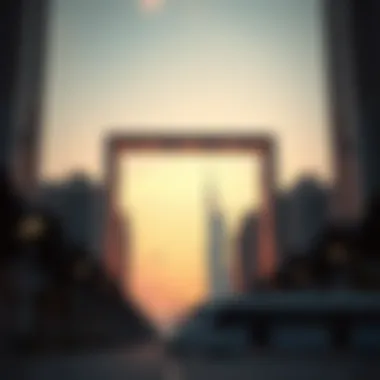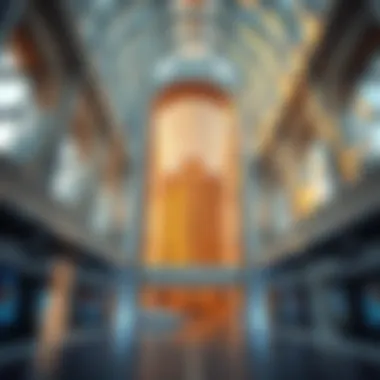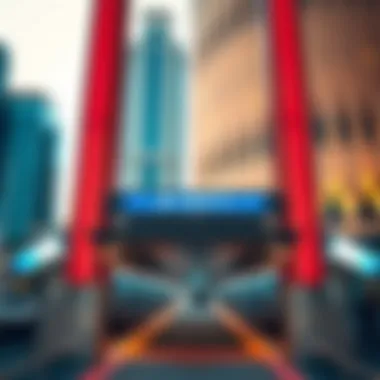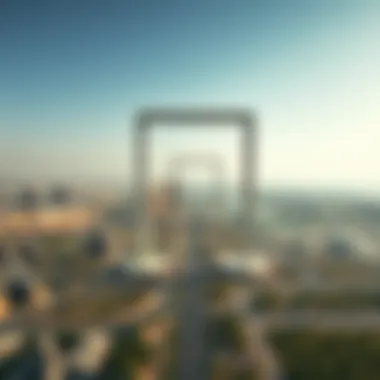Exploring the Connection: Dubai Frame and Metro System


Intro
The Dubai Frame stands tall as a vibrant emblem of modern architectural brilliance, symbolizing the city's rapid evolution and dreamy skyline. Nestled between the older districts and the new urban frontiers, it captures the essence of Dubai's past and future. But there's more to this colossal structure than meets the eye. It’s intertwined with the city’s metro system, creating a vital transport connection that enhances accessibility, boosts tourism, and fuels property investments in surrounding areas.
The significant integration of the Dubai Frame with the metro isn't just a matter of convenience; it's a transformative journey in urban planning and real estate dynamics. As an investor, homebuyer, realtor, or developer, understanding this relationship can be the difference between making a sound investment or missing out on prime opportunities. This article aims to explore the multifaceted aspects of the Dubai Frame metro connection, dissecting its implications for transportation, architecture, and the real estate market.
The context is set: let’s dive into the Market Trends that shape the landscape surrounding the Dubai Frame and its metro link.
Preamble to the Dubai Frame
The Dubai Frame stands as a significant symbol within the bustling cityscape of Dubai. It's more than just an architectural wonder; it serves as a gateway that links the past and the present of this vibrant city. This structure not only enhances the skyline but also represents the cultural and historical journey of Dubai. Understanding the Dubai Frame is crucial for anyone interested in the urban transformation of the city, especially when considering its connection to the metro system which facilitates access and connectivity for residents and visitors alike.
Historical Context
To appreciate the Dubai Frame fully, one must first consider its historical context. The Frame, inaugurated in January 2018, was designed by the renowned architect Faris Al-Mansoori. Its creation marked Dubai’s efforts to showcase its rapid development while acknowledging its rich heritage.
The site where the Frame resides carries layers of history. It is positioned strategically to offer views of both ‘Old Dubai’ and ‘New Dubai’. This concept of juxtaposition is not merely visual; it reflects the city's evolution from a modest fishing village to a global metropolis. The Dubai Frame encapsulates this narrative, making it a significant landmark for both locals and tourists.
Architectural Significance
Architecturally, the Dubai Frame is a marvel. Standing at 150 meters tall, it boasts a unique design reminiscent of a giant photo frame. The golden exterior is crafted to enhance sunlight reflection, creating a stunning visual appeal against the blue sky. Visitors standing on the glass bridge can enjoy breathtaking views that reveal the city’s contrasts, from the historic Dubai Creek to the ultra-modern skyline of Downtown Dubai.
The engineering techniques employed ensure durability and sustainability. The application of green building materials demonstrates a conscious effort to blend luxury living with environmental responsibility, emphasizing Dubai's forward-thinking approach to urban planning.
Visitor Experience
Visiting the Dubai Frame is an experience worth having. As you step inside, you are greeted with an interactive exhibition that vividly narrates the history of Dubai. The tour guides provide insights into significant milestones that shaped the nation's identity. The excitement escalates as visitors ascend to the top; the panoramic views are nothing less than spectacular, offering a bird’s-eye perspective of the city that few other places can provide.
Moreover, the Frame’s design encourages a seamless flow of visitors, making the journey enjoyable without overwhelming crowds. Thrill-seekers are drawn to the glass floor, which offers an exhilarating view of the ground below. More than just a viewing platform, the Dubai Frame invites people to reflect on the transformative journey of the city.
This structure is not just a tourist attraction; it fosters a deeper connection between the past and the present, making it essential for anyone navigating the urban environment of Dubai.
"Dubai Frame connects the thread of history with modernity, showcasing a city that respects its roots while building a bright future."
Given the metropolitan dynamics surrounding the Dubai Frame, its relationship with the Metro system enhances its significance for both accessibility and the overall visitor experience. This integration serves as the foundation for understanding the broader impact of the Frame on the urban fabric of Dubai.
Overview of Dubai's Metro System
Dubai's Metro system is a cornerstone of the city’s public transportation, offering a glimpse into modern urban mobility at its finest. As the world hustles and bustles, Dubai stands out with a metro system that not only serves as a daily commute solution but also highlights the emirate's commitment to sustainability and innovation. By examining the historical development, connectivity, and passenger usage of the Dubai Metro, we gain a nuanced understanding of its role in transforming local infrastructure and supporting community growth.
Development History
The story of the Dubai Metro began in the early 2000s amidst rapid urban expansion. The project was officially launched in 2005, marking an ambitious step toward reducing road congestion and lowering carbon emissions.
- First Line: The Red Line, stretching from Al Rashidiya to UAE Exchange, opened in 2010, immediately making waves with its electrifying pace and futuristic design.
- Expansion: Subsequently, the Green Line was introduced in 2011, connecting the historic areas of Dubai with newer developments, enhancing the metro's overall offering.
- Milestones: Over the years, additional phases followed, with ongoing plans to further streamline the network, making it an underground and above-ground marvel that links major points of interest in the city.


The foresight in this developmental phase underscores Dubai’s proactive approach in tackling urban challenges while accommodating forecasted population growth.
Connectivity and Reach
The interconnected nature of the Dubai Metro is vital for ensuring seamless transportation across the city’s diverse neighborhoods.
- Strategic Locations: Key stops near globally recognized landmarks, such as the Burj Khalifa and Dubai Frame, facilitate easy access for tourists and residents alike. This strategic placment fosters increased foot traffic and economic activity in surrounding areas.
- Integration: The metro system also seamlessly integrates with multiple transport modes including buses, taxis, and ride-sharing services, providing holistic connectivity that is user-friendly and efficient.
- Geographic Spread: Covering approximately 90 kilometers with more than 50 stations, the metro reaches vital residential districts, business hubs, and leisure spots, ensuring that no one feels left in the lurch.
The connectivity offered elevates the public transit experience in Dubai, demonstrating how strategic urban planning can encourage community cohesion and economic sustainability.
Passenger Statistics
Understanding passenger statistics is essential to grasping the impact of the Dubai Metro on the city. The numbers tell a compelling story of growth and evolution.
- Daily Ridership: As of the latest data, the metro handles upwards of 600,000 passengers each day, a testament to its reliability and effectiveness as a transit solution.
- Annual Trends: Year-on-year passenger growth trends indicate an upward trajectory, revealing increased dependence on public transportation amid evolving lifestyles.
- Demographics: A diverse ridership palette — from expatriates and tourists to daily commuters — reflects Dubai's international makeup, highlighting the metro's role in bridging cultures and enhancing local experiences across varied backgrounds.
"The Dubai Metro is not just a mode of transport; it's a testament to what a city can accomplish when ambition meets innovation."
This consistent increase in user engagement highlights the need for ongoing improvements and expansions, ensuring Dubai's metro continues to meet the demands of its dynamic population. By analyzing development history, connectivity, and passenger metrics, we can appreciate the profound influence of the Dubai Metro on the city’s infrastructure and daily life.
The Connection of Dubai Frame and Metro
The union of the Dubai Frame and the metro system is not merely a happy coincidence; it's a harmonious relationship that enhances urban living in one of the most dynamic cities in the world. This connection facilitates not just tourism but also improves the daily commute for residents while adding significant value to nearby properties. An insightful examination of this relationship reveals layers of benefits that extend far beyond the immediate vicinity.
Design Integration
The structural design of the Dubai Frame is not an isolated architectural marvel; it represents a careful thought process designed to complement the metro line. Built to resemble a giant picture frame, the structure stands tall at 150 meters, forming an impressive landmark against Dubai’s skyline. The integration of the metro station, located conveniently at its base, allows for seamless accessibility. Passengers can disembark from their trains and step straight into the captivating world of the Dubai Frame, where they will encounter exhibits narrating the city’s past, present, and future.
A key feature of this design is its duality; while the frame itself symbolizes the progress of Dubai over the years, the metro connection exemplifies modernity in urban transit. Riders experience a straightforward transition from the hustle of train travel straight into the contemplative space of the frame. This ensures that visitors do not have to navigate the complexities of city traffic, encouraging increased foot traffic and engagement.
Moreover, spacious pathways and modern signage further enhance the flow of movement between the structures. The architectural design takes into consideration the influx of tourists and locals alike, providing an inviting atmosphere that is characterized by open spaces and cultural interactions.
Operational Synergy
When discussing operational synergy, one must look at how the Dubai Frame and the metro system work hand in hand to foster an efficient urban transport experience. The metro's reliability is particularly critical in this equation. Operating on a fixed schedule, the metro provides a predictable arrival time for passengers heading towards the Frame, bolstering the planning capabilities for both tourists and local commuters.
The strategic positioning of the metro station ensures that visitors are not only attracted to the Frame but also facilitated by public transport, which is becoming increasingly paramount in dense urban settings. Moreover, the connection has encouraged more frequent use of the metro, and with it, a culture of public transit that reduces carbon footprints, aligning well with the city’s sustainability goals.
Another noteworthy point is the interaction among different modes of transport. For example, nearby bus stations and taxi services have seen increased footfall, as passengers often prefer to switch from one mode of transit to another, which becomes exceptionally easy due to the investments in infrastructure surrounding the Dubai Frame. This not only raises the efficiency of daily commutes but also enriches the overall visitor experience, making it enjoyable rather than a chore.
"This connection exemplifies urban synergy, demonstrating how infrastructure can evolve through innovative thinking and design."
In summation, the connection of the Dubai Frame and the metro system is a prime example of careful urban planning and innovation, creating an environment that supports both the local community and tourism. Not only does it provide practical benefits, but it also shapes the urban landscape, embodying the spirit of modern Dubai.
Impact on Local Communities


The integration of the Dubai Frame with the metro system extends far beyond mere aesthetics. This connection brings about meaningful changes to local communities, shaping the dynamics of urban living, real estate, and the broader economic landscape. In this section, we will delve into three critical aspects: enhancing accessibility, real estate implications, and the economic boost provided to surrounding areas.
Enhancing Accessibility
Accessibility plays a pivotal role in the way residents and visitors interact with the urban fabric of Dubai. The link between the Dubai Frame and the metro enhances this accessibility significantly. Public transport systems like the metro can act like veins through the body of a city, nourishing neighborhoods by connecting them to vital resources such as workplaces, schools, and recreational facilities.
Residents now enjoy reduced travel times and increased convenience. The Dubai Frame's proximity to metro stations means that a family, for example, can hop on the metro and get to their weekend brunch with ease, rather than battling the notorious traffic jams that often plague the city. This seamless integration also encourages greater footfall around the Dubai Frame, attracting not just tourists but also local residents who appreciate the ease of getting around without needing a car.
By making the area more accessible, the metro doesn't merely benefit individuals; it enhances community cohesion. Events and gatherings that occur around the Dubai Frame become more attended, thanks to the ease of transport.
Real Estate Implications
The influence of the Dubai Frame on local real estate markets cannot be understated. As public transportation becomes more accessible, property values in nearby areas generally rise. Investors and homebuyers eye the vicinity as a prime opportunity. Properties near metro stations typically have a higher demand. This trend is evident in the neighborhoods adjacent to the Dubai Frame, where developers are vigorously focusing on building residential units to satisfy the burgeoning demand.
Moreover, the improved connectivity to the metro elevates the desirability of living close to the Dubai Frame. This is not just about convenience; it’s about living in a cultural hub that merges modernity with the historical significance of Dubai. As prospective homebuyers consider the benefits of proximity to such landmarks, the prospects for real estate investment strengthen.
In terms of rental markets, properties close to the metro tend to attract tenants willing to pay a premium for the convenience. This situation presents a lucrative opportunity for real estate investors, translating into higher returns on investment.
Economic Boost to Surrounding Areas
Beyond the direct impact on real estate, the Dubai Frame metro connection heralds an economic renaissance for nearby neighborhoods. Increased accessibility attracts businesses, creating new job opportunities and entrepreneurial ventures. A diverse mix of cafes, shops, and galleries are popping up around the Dubai Frame, inviting both residents and tourists alike.
The influx of visitors offers local businesses an exceptional opportunity to grow. Imagine a local coffee shop seeing a spike in customers early in the morning as commuters grab a drink before their daily travels. Retail shops and service providers enjoy sustained foot traffic, resulting in flourishing local economies.
Furthermore, larger scale developments are likely to follow as the area gains in popularity. Infrastructure improvements, like new roads or parking facilities, may also come into play, further enriching the economic landscape.
Benefits for Tourists and Residents
The union of the Dubai Frame and the metro system presents compelling advantages for both tourists and local residents. This synergy significantly amplifies the experience of exploring one of the most iconic structures in Dubai, making it not merely a visual wonder but also a highly accessible landmark. With the bustling city at their feet, visitors and residents alike find themselves at the crossroads of convenience and vibrancy, all thanks to seamless connectivity.
Tourist Influx and Engagement
Tourism in Dubai has always been a driving force behind the local economy. The Dubai Frame serves as a magnetic attraction for tourists, drawing them in with its unique architectural design and breathtaking views. Link this spectacular structure with the metro, and you've got yourself an efficient travel route that encourages a steady influx of visitors.
Key Factors Influencing Tourist Engagement:
- Strategic Location: The proximity of the metro to the Dubai Frame allows tourists to skip the hassle of navigating congested streets. With the metro's proximity, visitors can hop on a train and within minutes find themselves standing under the frame, with fantastic views above.
- Diverse Attractions: Situated near cultural hotspots like Zabeel Park, tourists can explore multiple attractions in one trip, enhancing their overall experience. It transforms a solitary visit into a full day of discovery without heavy investment in transport.
- Cost-Effective Travel: The affordable metro fares make it accessible for all, allowing tourists on any budget to experience the Frame without straining their wallets.
- Promotional Activities: Local tourism boards often run events or discounts related to the Dubai Frame, incentivizing visitors to engage more deeply with the cultural offerings.
By ensuring easy access, the metro not only promotes the Dubai Frame but also stimulates various local businesses, from eateries to souvenir shops, enriching the overall tourist experience.
Convenience for Daily Commuters
For residents, the connection to the Dubai Frame through the metro means more than just a transport solution; it reflects a broader shift in urban lifestyle. Daily commuters benefit significantly from this integration, as it reduces travel time and enhances their quality of life.
Advantages for Commuters:


- Time Efficiency: With trains running frequently, commuters can expect reduced waiting times. A shorter commute translates to more time available for family, work, or leisure activities.
- Stress Reduction: Avoiding the tangled traffic that often plagues Dubai streets allows commuters to start and end their day on a positive note. As they glide smoothly towards their destination, they can enjoy views that include the ever-impressive Frame.
- Environmental Benefits: Using public transport can significantly diminish the carbon footprint. This shift towards mass transit aligns with global sustainability trends, contributing to cleaner urban air.
- Networking Opportunities: Regular encounters with fellow commuters provide an avenue for social interactions, employment networking, or simply a chance to chat about shared experiences.
This integration of the Dubai Frame with the metro plays an instrumental role in shaping a modern urban landscape that caters to both tourists and residents alike, reinforcing Dubai’s reputation as a forward-thinking city.
"Good transport can change the way people experience a city—making it more accessible, affordable, and enjoyable."
This burgeoning era of transport connectivity stands not only to enhance livability but also to foster a sense of community among residents, making the Dubai Frame a central pillar in the city’s evolving narrative.
Future Developments and Considerations
Looking towards the future, the synergy of the Dubai Frame with the metro system serves as a crystal ball for predicted urban expansion and sustainability efforts in the region. As more people flock to this thriving metropolis, the example set by the Dubai Frame and its integrative approach to public transportation stands to transform the urban landscape into a more accessible and environmentally-conscious area.
Predicted Urban Expansion
The connection between the Dubai Frame and the metro is not simply a matter of convenience; it's a harbinger of the city’s anticipated urban growth. Analysts predict that areas surrounding this landmark will experience an uptick in development projects, such as new residential complexes, commercial spaces, and leisure facilities.
More specifically, there are several factors fueling this expansion:
- Proximity to Attractions: The popularity of the Dubai Frame as a tourist destination naturally draws interest from both investors and developers. They see an opportunity to create mixed-use developments that cater to tourists and locals alike.
- Strategic Planning Initiatives: The local government is driven to improve infrastructure and are likely to promote zoning reforms giving priority to developments near key metro stations.
- Increased Property Values: As demand rises, so too will property values, which will naturally spur more construction projects in hopes of capitalizing on the burgeoning real estate market.
The integration of metro stations with iconic structures like the Dubai Frame not only encourages developer enthusiasm but also elevates community engagement. The future landscape will likely foster greater foot traffic, resulting in vibrant public spaces that encourage social interaction.
Sustainability Initiatives
As we stride into the future, sustainability is not just an option; it has become a necessity, especially in urban planning. The link between the Dubai Frame and the metro system serves as a template for sustainable transportation. These initiatives emphasize reducing carbon footprints while enhancing quality of life. Here are key components to consider:
- Energy-Efficient Design: New developments around the Dubai Frame are expected to prioritize innovative, energy-efficient technologies. This could include solar panels, green roofs, and natural ventilation systems aiming to lower overall energy consumption.
- Public Transport Alternatives: With the metro's critical role in the public transportation network, more commuters will lean towards using public transport rather than personal vehicles. Reduced vehicular traffic means lower emissions, leading to better air quality—a win-win for sustainability.
- Green Spaces: Planning for parks and sustainable landscapes around the Dubai Frame could provide residents and visitors with much-needed green zones, easing urban heat issues and boosting biodiversity.
As these sustainability initiatives take root, Dubai is poised to offer a landmark example of how cities can pave the way for environmentally-responsible growth while still attracting investments. The future of urban development near the Dubai Frame stands not just as a response to the growing population, but also as a proactive approach to ensuring livability for generations to come.
Closure
Navigating the integration of the Dubai Frame with the metro is not just about transport; it's a window into how modern urban landscapes evolve. This article sheds light on the multifaceted relationship between architectural wonders and public transport systems, ultimately enriching the urban fabric of Dubai. The real magic lies not only in the stunning visuals of the Dubai Frame but also in its practical implications for both residents and visitors.
Summarizing Key Insights
One cannot overlook the vital components discussed throughout this narrative. For instance, the seamless connection between the Dubai Frame and the metro system not only enhances accessibility but also uplifts the surrounding neighborhoods. Tourists and locals alike benefit from this synergy. Notably, it underlines the following key insights:
- Integration of Design and Functionality: The architectural elegance of the Dubai Frame complements the metro, leading to visually appealing and user-friendly urban spaces.
- Boosting Economic Activity: The influx of tourists fosters economic opportunities for local businesses and encourages real estate investments.
- Sustainability Considerations: Thoughtful design choices and sustainability initiatives are important for future urban planners and developers, ensuring that progress does not come at the expense of ecological balance.
These elements paint a clear picture of how urban planning and design can work hand in hand, resulting in a thriving metropolis.
Final Thoughts on Future Trends
As we look ahead, several trends appear on the horizon. With the ongoing urban expansion and a growing population, the future of the Dubai Frame and metro connection offers both challenges and opportunities:
- Continued Expansion of Public Transport: As new metro lines are introduced, the connectivity to landmark structures like the Dubai Frame is likely to enhance, opening doors for innovative transport solutions.
- Focus on Smart City Concepts: Implementing smart technologies within the metro system will not only improve commuter experience but also elevate security and efficiency.
- Increased Emphasis on Green Spaces: Future developments may prioritize green spaces, integrating more parks and recreational areas around the Dubai Frame, making it a central hub for community engagement.
In closing, the evolving relationship between the Dubai Frame and the metro illustrates a progressive vision for urban living. For investors, homebuyers, and developers, understanding these trends might guide smarter decisions today that pave the way for future growth. The key takeaway is that looking beyond mere structures to how they facilitate life and interaction in the city is essential for nurturing a vibrant urban landscape.
"The future belongs to those who believe in the beauty of their dreams." - Eleanor Roosevelt
For further reading, consider exploring resources on urban development at Wikipedia, Britannica, and Government Resources for updates on public transport initiatives.















